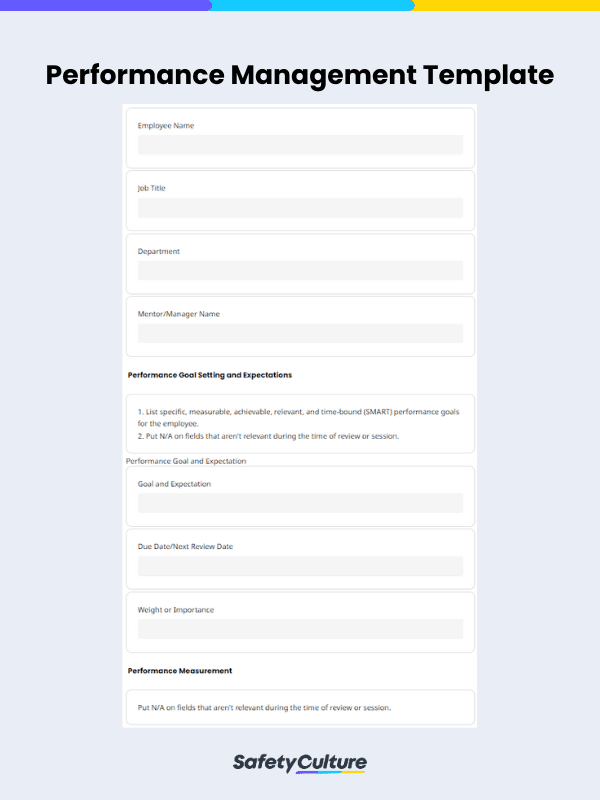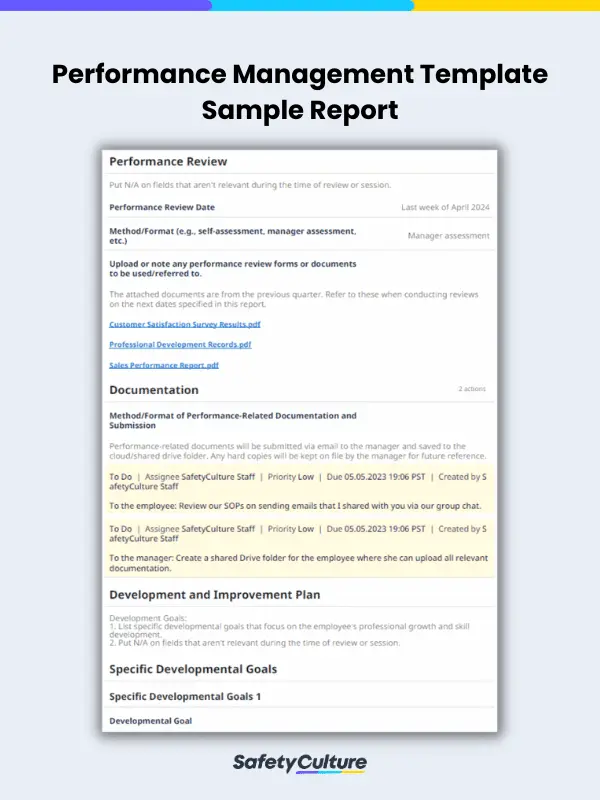What is a Performance Management Template?
A performance management template is a pre-designed tool and a standardized framework used by organizations to ensure consistency and fairness in managing employee performance. It typically includes various sections and elements that help employers and managers set performance goals, define expectations, establish measurement methods, conduct performance reviews, create development plans, and document performance-related information.
Why Use a Template for Performance Management
Using a template can help organizations improve their overall performance management system in various ways, including the following:
- Provide a clear and structured approach to managing employee performance
- Ensure consistency and fairness in evaluating and measuring performance
- Set clear expectations for performance goals and behaviors
- Facilitate effective feedback and coaching conversations
- Document performance-related information for future reference or recordkeeping purposes
- Support employee development and growth by promoting a performance-driven culture
- Improve overall organizational performance and productivity
Types and Examples of Performance Management Templates
To ensure a holistic performance management system in your organization, using specific templates for each part or a comprehensive one for the entire process is advisable. For example, the following types of a performance management process checklist template can guide you through conducting performance management efforts:
- Plan: Goal-setting templates
- Monitor: Performance improvement plan and check-in templates
- Review:
- Reward: Performance incentive plan templates
- Overall: Performance management templates
What to Include in a Performance Management Template
The following key components must be included in a template that you’ll use during your performance management initiatives:
- Performance goals – specific, measurable, achievable, relevant, and time-bound (SMART) goals or objectives that employees are expected to achieve, aligned with the overall organizational objectives
- Performance expectations – expected behaviors, skills, and competencies that employees should demonstrate to meet the performance goals; a clear description of the desired performance levels and the criteria used to assess the performance
- Performance measurement – methods and tools used to measure performance, including metrics or KPIs to track progress
- Feedback and coaching – suggestions or strategies for effective feedback techniques, coaching strategies, and ways to address performance gaps in a constructive manner
- Performance review process and documentation – frequency and format of the reviews, who are involved, and how performance data will be collected, analyzed, and filed for recordkeeping purposes
- Development and improvement plans – suggestions for training, mentoring, or other development opportunities to help employees enhance their skills and capabilities or improve their performance
- Sign-offs – signatures of the employee being evaluated and their manager for due acknowledgment and understanding of the guidelines and recommendations stated in the filled-out template
Also, note that the specific components of a performance management template may vary depending on the organization’s requirements and preferences. The template can be customized to suit the unique needs and culture of the organization while ensuring that it provides a clear and structured approach to managing employee performance.
How to Create and Use a Performance Management Template
To guide you, follow these steps to ensure you cover everything that you need:
- Identify the most important elements and sections you must include in the template to ensure it’s tailored to your organizational needs.
- Clearly communicate the components outlined in the template and ensure managers and employees understand its purpose and proper use.
- Work with employees to set performance goals that are aligned with the organization’s objectives, mutually agreed upon by the employee and their manager.
- Continuously monitor and track employee performance and provide regular feedback and coaching.
- Document performance data and work with employees to create development plans as needed.
- Regularly review and update the performance management template to ensure that it remains relevant and effective.
- Use the filled-out or completed performance management template as a supporting document for providing recognition and rewards to employees who meet or exceed performance goals.
FAQs About Performance Management Templates
Yes, performance management templates are typically customizable by aligning them with your organization’s goals, culture, and policies. You can also include any additional sections or information that are relevant to your overall performance management system.
The frequency of updates may vary depending on the organization’s needs, but it’s commonly done annually or as needed to keep the template current and effective. Specific teams, departments, or employees can have unique performance measures and goals, so this must also be taken into account when updating templates.
Here are some tips you can consider when ensuring that these templates are helping your organization achieve its goals when it comes to performance management:
- Clearly communicate to managers and employees how the performance management template should be used by providing training.
- Set expectations for consistent and timely use.
- Monitor its use and provide feedback to managers and employees.
- Provide ongoing support in the form of guidance and resources.
- Improve the template to ensure it remains relevant and effective.




